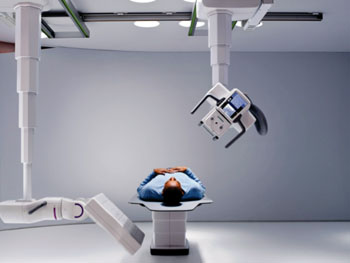Twin Robotic X-Ray System Combines Care and Productivity
By MedImaging International staff writers
Posted on 11 Nov 2015
The world’s first twin robotic X-ray scanner delivers a combination of high asset utilization, new clinical insights, and less patient positioning and transfers.Posted on 11 Nov 2015
The Siemens Healthcare (Erlangen, Germany) Multitom Robotic Advanced X-ray (Rax) offers radiology departments a comprehensive range of applications by integrating multiple X-ray capabilities in one room, thus improving asset utilization and saving on costs. Modalities include radiography, tomography, fluoroscopy, and angiography; multi-clinical options, including trauma, orthopedic, intervention, pain management, and more; static, dynamic, and three dimensional (3D) scanning; and multiple patient configurations.

Image: The Multitom Robotic Advanced X-ray (Rax) system (Photo courtesy of Siemens Healthcare).
The two ceiling-mounted arms of the Multitom Rax can be moved into position automatically using robotic technology, and they can also be moved manually (servo motor supported) when required, such as for fine adjustment. One arm moves the X-ray tube and the large touchscreen control, while the other carries a 43 x 43 cm flat panel detector. Consequently, there is no need to reposition the patient or to change rooms for further imaging procedures, which makes examinations less painful and less time-consuming.
Multitom Rax also offers Real 3D—the ability to perform X-ray examinations and diagnoses under natural weight-bearing conditions, such as in lying, sitting, and standing conditions, allowing comfortable patient positioning with an open design, while still maintaining low-dose protocols. Another comfort feature is that the scanner revolves around the patient utilizing an open, patient-centered design, resulting in less patient risks and pain due to fewer transfers and repositioning, especially important in pediatric, geriatric, bariatric, immobile, and trauma patients.
“The robotic technology ensures a new level of precision and automation, enabling a new level of standardization and throughput,” said Francois Nolte, head of the X-ray products business line at Siemens Healthcare. “The precise positioning of the arms in all three planes makes the examinations so much easier: regardless of whether the patient is standing, sitting or lying down, the robotic arms move with perfect accuracy using robotic technology. Our strategy is based on the principle that the system moves, not the patient, which reduces risk of additional injuries and pain.”
The Siemens Multitom Robotic Advanced X-ray (Rax) also offers optional wireless, portable, detectors in two different sizes that can be positioned directly between a wheelchair or mattress and the patient's back, which avoids the need to sit the patient up. Preprogrammed safety zones, an automatic stop in response to contact, and automatic control of the robotic arms that ensures that they will always take the shortest and safest route to reach the next programmed position also improve safety.
Related Links:
Siemens Healthcare














